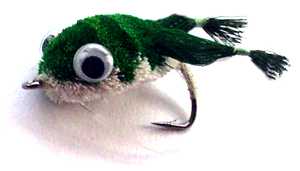Green and White Kicking Frog Bass Bug
Amphibians like frogs are not that good at swimming and no match for a hungry Bass who wants an easy evening meal so tie on a kicking frog pattern.

DEERHAIR BASS BUG FLY PATTERNS. Hook size 6 - $US each
Largemouth and Smallmouth Bass are opportunistic feeders. If anything suggests food they will try and eat it so long as they do not have to venture too far from their hiding place. You can have hours of fun fishing from the shore, wadding in the shallows or sitting in a boat close to the shore looking for that bass hiding place. The deerhair used in construction the Green and White Kicking Frog bassbug makes this fly very buoyant and easy to fish on the water surface. I use short strips of the fishing line to imitate a frogs erratic progress down the river. Have a look at the way a real frog swims and count how many times it kicks its legs per second and try to imitate the same rate in the amount of jerks you give on the line. Notice that frogs often pause whilst swimming as they look around for food and areal threats from herons.
Learn how to look for bass
The ability to work out where you can find bass in a given body of water at any time of year is not a God given mystic gift. It is a skill that can be learnt. Spend some time on the shore or a boat dock observing the characteristics of the lake. This is time well spent and will lead you to the bass a lot quicker.
The first thing you should look for are large areas of shallow water that are less than ten feet deep, generally known as 'flats'. They can be around a cove, tributary streams, on sand banks or in the center of the lake. Bass are really shallow water fish. Even on very large lakes such as the great lakes in Central North America they will concentrate on the large flats that can be found extending out from the shore line.
Buy a good map with the water depths shown. Look for areas on the map where the under water contours are wide apart. This is where you should try casting for bass. If the lake you are fishing has a lot of shallow water the fish obviously have a lot of choice. They will prefer shallow water with cover. Fish around weedy shore lines, boat docks, and any fallen trees. Another way to identify shallow water is to look for vegetation growing in the water. Small baitfish like swimming around the vegetation as they can more easily find small aquatic insects and therefore the bass like hunting in these areas for the Minnows.
Although, as I mentioned, bass are basically shallow water fish they do like quick access to deep water for a safety. Deeper water can be found on the flats when a channel is formed by stronger flowing water passing over the shallow section and over the years eroding the lake bed. This is normally found when rivers or streams enter lakes. To help detect channels look for flooded trees that sometimes line the points of deeper water.
Bass also like vegetation transition zones which occur through change of water depth and ecosystem where marsh grass, pepper grass and bulrushes change to smaller aquatic plants. They are great Bass hangouts but it is essential to have weedguards on your flies for fishing these hot locations.
Over hanging trees or flooded shoreline trees are also great locations to find bass. They love the cover in this shallow water. Swim your flies through them and wait for the hit. Rockwalls and boat docks and piers also provide cover that Bass like.
Off color water will bring bass up to the surface, while clear water pushes them deeper, or closer to cover. In colored water fish a bass bug that makes a lot of noise. Try a popper or diving bass bug. In a lake that has few shallow flats and a very steep shoreline you might have to concentrate on parts of the shoreline that stick out in a point to find shallow water as sediment concentrates around irregular shoreline features.


Bass Bug books

